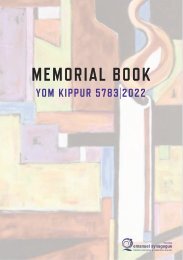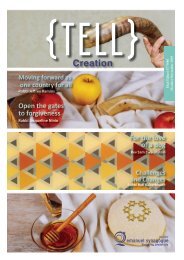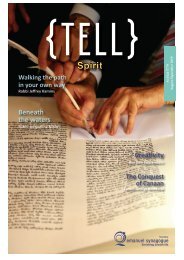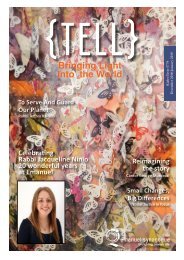TELL - December 2019 - February 2020
TELL - the magazine of Emanuel Synagogue, Sydney The Identity issue
TELL - the magazine of Emanuel Synagogue, Sydney
The Identity issue
You also want an ePaper? Increase the reach of your titles
YUMPU automatically turns print PDFs into web optimized ePapers that Google loves.
it wasn’t mine to lose and yet I feel
grief and a growing sense of anger at
the carelessness and irresponsibility of
people who would let this happen.
Some of the Knitting Nannas on the way to the conference
Next stop Bohena Creek. Can’t see
an actual creek with water, just sand,
but Dan explains, ‘Dig down no more
than an elbow length and you’ll hit
water’. The creek drains from the
Pilliga onto nearby Namoi Valley –
rich agricultural country, a major food
bowl for Australia. Dan tells us the
miners have been known to dump
their contaminants into the sandy
beds conveniently leaving a nondescript
wet patch. The concern is the
downstream impact when approval
is finally given for the proposed 850
wells, that’s one every 700 metres.
The rains don’t come often, but
when they do Bohena Creek is big
and floods into the farmlands. They
rely on this and artesian water. The
Pilliga is known to be a recharge site
for this edge of the Great Artesian
Basin. I already know that fracking
uses megalitres of water and relies
on government approvals to tap into
natural sources. Dan tells us that
each well will create 150 million
litres of contaminated ‘produced
water’. The facts are swirling around
my head, I can’t understand why
we’re not learning from experience
– preserving and protecting. With
these sorts of track records, how
can you trust mining companies
with government approval not to
contaminate precious water resources?
We talk about the many flares that
would keep firing 24/7, lighting
up the dark night sky. What would
this do to nearby Coonabarabran
Siding Springs Observatory
and their international work in
astronomy? What happens when
there’s a bushfire? The local volunteer
Rural Fire Service has said it won’t
send crews in, too dangerous.
A grey silence descends on us all.
By now all we can do is shake our
heads in disbelief but Dan can’t
stop telling us what he knows. It
spills out and we listen to all he’s
seen and researched. Finally, he
ends and says, ‘That’s it! Now you
know. What I can’t understand is
why people aren’t listening and
fighting this. Thank you for taking
the time to see it and for listening.’
It’s time to leave but before we get
into our cars, the Nannas thank Dan
and give him some money collected
during the morning. He didn’t expect
it and shyly accepts. It will help pay
the bills. He’s a tall, lanky bloke and
towers above the Nannas gathered
around him. He looks down at them
saying thank you. Spontaneously the
Nannas close in with a huge, group
hug. It’s like Dan is briefly wrapped in
their tender warmth and caring. He
closes his eyes and I notice some tears.
The moment passes and the Nannas
promise to share the knowledge
and pain. Someone listened.
CONCLUSION
We set out on this journey
fascinated to learn how an
eco-activist movement of
older women had grown
from one small group
to over thirty in only six
years. Being educators we
suspected it had much to
do with learning. What we
found were women who
had been marginalised due
to age and gender, who
were determined to be productive and
creative social change agents taking
action for a low-carbon future. Our
data show many of these women
had never done anything like this
before. Drawing on one another’s
strengths, learning from one another,
taking time to critically reflect as
they ‘sit, knit and plot’, these women
have built an identifiable learning
system consistent with domains of
learning in previous literature and
Social Movement Learning Theory
frameworks to date. Nannagogy
extends the field giving us new
insights through the intersectionality
of gender, identity and ecoactivism.
We know that gender
blindness continues to be an issue in
environmental education (Gough,
Russell, & Whitehouse, 2017;
Larri, & Newlands, 2017). Through
Nannagogy we challenge social
movement learning theorists and those
working in social movements to be
vigilant and inclusive. In the words of
the Nannas (https://knitting-nannas.
com/ ), 'There seems to be a public
misconception that political activists
and protesters are young, unwashed
and unemployed or unemployable.
Not true. Anyone can be an activist
and contribute to change. Any type
of action can be strong. If we get
together and use our strengths, we can
make change …
You don't have to be a Nanna;
you don't have to knit to save
the land, air and water for
the future generations!'
For more information about the
full article or the Knitting Nannas
(full title is Knitting Nannas
Against Gas and Greed aka KNAG)
please feel free to contact Larraine:
larraine.larri@my.jcu.edu.au
HEALING THE WORLD
33















